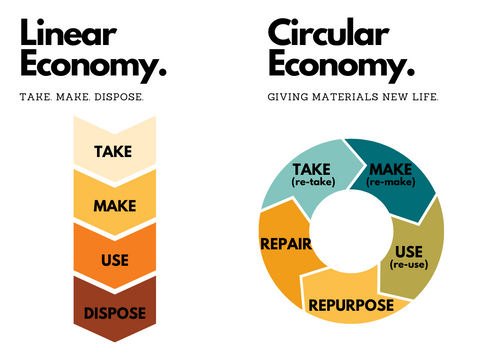In a world grappling with the consequences of overconsumption and environmental degradation, the concept of a circular economy has gained significant attention. Unlike the traditional linear economy that follows a "take-make-dispose" model, a circular economy aims to redefine our approach to resource usage and waste management. This blog post will delve into the fundamental differences between a circular economy and a linear economy, emphasizing why the transition to a circular economy is crucial for a sustainable future.
At Pumped, our mission is to help grow the circular economy by offering customers the option to bring in their own containers, this eliminating waste from the transaction at all. We also offer jars on deposit for our home delivery system and aluminum bottles can be sent back to be washed and reused. All of these efforts allow us to reduce waste and keep our containers in circulation. In addition, we make every effort to support closed-loop businesses. We send containers back to manufacturers for continued reuse.
Understanding the Linear Economy:
The linear economy is based on a linear flow of resources, with a focus on extraction, production, consumption, and disposal. Key characteristics include:
- Take-Make-Dispose Model:
- Resources are extracted from the earth at an unsustainable rate, contributing to resource depletion.
- These resources are processed, manufactured into products, and consumed.
- After use, products are discarded as waste, typically ending up in landfills or incineration facilities.
- This linear flow results in resource depletion and environmental pollution.
- Limited Lifespan of Products:
- Products are often designed with a short lifespan, encouraging frequent purchases- think about kitchen appliances and electronics produced today vs. 20 years ago. When I tell people I rock an IPhone SE – they think I’m crazy!
- Planned obsolescence and rapid product turnover contribute to excessive resource consumption and waste generation.
- Linear Supply Chains:
- Supply chains are typically one-directional, focused on producing and delivering goods to consumers.
- Little consideration is given to the potential for recycling or reusing materials after the product's end-of-life.
Embracing the Circular Economy:
The circular economy is based on the principles of regenerating resources, minimizing waste, and maximizing the value of products and materials. Key characteristics include:
- Circular Flow of Resources:
- Resources are viewed as valuable assets that should be preserved within the economy for as long as possible.
- Strategies such as recycling, reusing, and repurposing are prioritized to extend the lifespan of materials and products. But the reality is that in today’s world, recycling doesn’t happen as often (or in the same way) you think. Therefore, efforts are made to reuse and repurpose materials first.
- Resources circulate in a closed-loop system, reducing the need for extraction and minimizing waste generation.
- Designing for Longevity and Regeneration:
- Products are designed with durability, repairability, and recyclability in mind.
- The goal is to minimize waste generation and maximize resource efficiency throughout the product's lifecycle.
- Designers focus on creating products that can be easily disassembled, repaired, or upgraded to extend their lifespan.
- Closed-loop Supply Chains:
- Supply chains become interconnected loops where waste from one process becomes the input for another.
- Collaboration and coordination among stakeholders are crucial to optimize material flows and reduce reliance on virgin resources.
- Recycling, remanufacturing, and refurbishing play a significant role in creating closed-loop systems.
Why We Need to Move to a Circular Economy:
Transitioning to a circular economy offers numerous benefits for the environment, society, and the economy. Here are some key reasons why the shift is necessary:
- Resource Conservation:
- Maximizes the use of existing resources, reducing the need for new extraction.
- Decreases pressure on ecosystems and preserves natural resources for future generations.
- Waste Reduction:
- Promotes the reuse, repair, and recycling of materials, diverting them from landfills.
- Reduces pollution and minimizes the environmental impact associated with waste disposal.
- Economic Opportunities:
- Generates new business models, job opportunities, and revenue streams through recycling, remanufacturing, and service-oriented approaches.
- Stimulates innovation and the development of sustainable technologies.
- Extends the lifespan of products, reducing the energy-intensive processes involved in manufacturing new goods.
- Decreases carbon emissions and mitigates climate change.
- Diversifies the economy by reducing dependence on finite resources and volatile commodity markets.
- Enhances the ability to adapt to disruptions in resource availability and price fluctuations. Think about the issues we’ve had over the last few years with shipping delays and shortages of some of the raw materials required to produce goods. If we were operating in a circular economy, we would not have been as adversely affected.
- Improves resource access and affordability for underserved communities.
- Encourages collaboration and knowledge sharing among businesses, governments, and citizens.
Overcoming Challenges and Seizing Opportunities:
To accelerate the transition to a circular economy, certain challenges must be addressed while seizing the opportunities presented. Here are some key strategies:
- Design and Innovation:
- Prioritize eco-design principles to create products that are efficient, durable, and legitimately recyclable.
- Encourage research and development for sustainable materials and production techniques.
- Policy and Regulation:
- Implement supportive policies that incentivize circular practices and penalize linear models.
- Foster collaboration between governments, businesses, and NGOs to create a conducive regulatory environment.
- Promote awareness among consumers about the benefits and importance of the circular economy.
- Integrate circular economy principles into educational curricula at all levels.
- Encourage collaboration among businesses, governments, and stakeholders to build resilient circular supply chains.
- Foster partnerships for knowledge exchange, innovation, and scaling up circular initiatives.
The linear economy has proven unsustainable, driving resource depletion, waste generation, and environmental degradation. Transitioning to a circular economy offers a transformative solution that aligns economic growth with environmental stewardship. By reimagining our approach to resource usage, waste management, and product design, we can create a more sustainable and prosperous future for generations to come.
Embracing the circular economy is not only a necessity but also an opportunity to build a resilient, regenerative, and equitable world. Let's seize this opportunity and embark on a transformative journey towards a circular economy!




